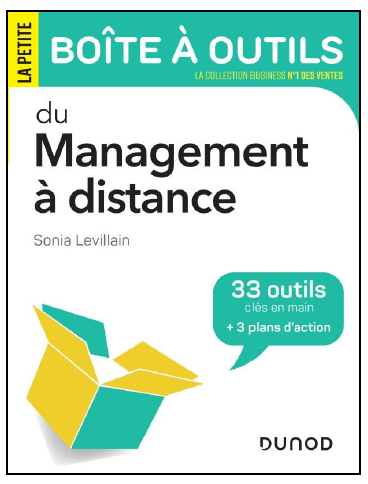“Back to the office”: 5 keys to a hybrid management that is both effective and productive – interview with Sonia Levillain

Share

Since March 2020, a new page in the history of work and organizations is being written, explains Sonia LEVILLAIN, professor in sustainable management at IÉSEG, in her new book*. The Covid-19 pandemic led to an implementation of remote working that no one could have imagined a few months before. While many people have begun to return to the office, many companies are shifting to hybrid work arrangements involving both teleworking and time at the workplace. This shift to ‘hybrid’ poses many managerial and organizational challenges for companies in all sectors. How can they sustain motivation, commitment, and performance of employees? How can employees work efficiently in a hybrid team? How to put in place hybrid arrangements that meet the needs of different jobs and professions?
For Sonia LEVILLAIN, this new (hybrid) organization presents an opportunity for both managers and organizations to challenge themselves and implement sustainable and humanistic management practices. “The arrival of a new generation of employees, the need for more flexibility in companies, the complexity of problems and the health crisis have highlighted the need for management that is both sustainable, in order to be able to adapt to these different situations, and humanistic, because it is necessary to combine demands and benevolence,” she explains.
“We have the opportunity to implement a management style based on respect for individual and collective intelligence; and that allows us to develop employees’ capacity to learn and adapt and to create value. This means that we are moving towards a pedagogical style of management rather than a top-down and hierarchical management, which remains anchored in a certain number of managers.”
Her book (*”La petite boite à outils du management à distance”, Editions Dunod) puts forward a series of tips and practical tools to help managers in all sectors. She shares five keys to a hybrid management that is both effective and efficient.
1/ Redefining the organization of work collectively around the notion of meaning.
“With a hybrid organization, where some employees work remotely and others on site, the simple processes used before no longer work. This means that the organization of work must be rethought around the meaning of the tasks/missions and role of a department or service within the company (What is our purpose? For whom? etc.)
Many employees have developed habits during the pandemic to facilitate their personal life (for example, to facilitate looking after children or administrative appointments). Therefore, we have noticed a more individual tendency that developed during this period, whereas with this return to hybrid mode and the need to review the organization of tasks/missions, we need to (again) ensure the collective interest comes before the individual. This is part of this redefinition of our tasks, their meaning, and how we execute them. This will bring two benefits: firstly, it will allow us to refocus our work, and secondly – if this is done collectively and with a reflection on the meaning of our missions – it will nourish motivation and long-term engagement.”
2/ Determine common times when all employees in the department are physically present (and use them wisely)

“We need these moments to share the pleasure and the need for being together. This feeds the feeling of belonging to an organization. We need this time to be dedicated to sharing information and problem solving.
Information sharing is very important because it is not shared in the same way remotely. Employees, discussing over coffee for example, will generally share more broadly (than when discussing remotely) and will nourish interpersonal relationships within an organization. In terms of problem solving, with for example a team of different profiles working on the management of a project, these moments together allow us to really leverage collective intelligence. This intelligence is not the simple addition of our individual intelligence, but results from the alchemy that will occur as employees share and bounce around ideas during exchanges. There is more energy and efficiency during these moments when we are physically present.”
3/ Managing by objectives and steering performance.
“Managing by objectives is not new, but the idea is that everyone must know what they have to do, why, for when, and with whom, in order to properly organize their work and mobilize energies where they are needed. We know where we are heading and we can leave (employees) autonomy in the implementation because we are working with professionals who know what they have to accomplish, and what resources they have…”.
“In terms of steering performance, managers must try to measure in a relevant and efficient way the follow-up of different tasks. The idea is to have fewer KPIs (key performance indicators) but an effective form of reporting. Very often, too many reports are requested from employees in the field, who then spend too much time filling in tables with information that is not always relevant to them and therefore not used. It’s not easy, but we have to try to formulate key indicators with the employees that will allow us to know if the performance is good, not only in terms of activities, profitability and productivity, but also in terms of quality and human functioning in the department”.

4/ Organize the flow of information and feedback: to build trust, performance and reactivity
“To summarize, this generally means less control and more feedback from employees. This is very important because I’ve seen many employees, when they came back to the office in September, who were unhappy or angry. For a year and a half they have been working remotely and fulfilling their missions with a lot of autonomy, and they have the impression that the old practices of control and hierarchical management are back. Even if it is natural and legitimate that the manager needs to be informed, this feeling of control is not necessarily well perceived by employees. It is therefore necessary to develop the employee’s habit of giving feedback on his or her own, during identified times with the manager. He/she must understand that a manager is not there to “control” but he/she needs to be informed about how tasks are progressing. Moreover, these meetings with the manager are occasions where a person can ask for or provide help. These are important moments. At the same time, it’s important to develop a system to manage emergencies, to be able to react and respond to a crisis situation.”
5/ Develop managerial efficiency by combining methodological rigor and quality of relationships
“This means finding a balance between our demands/expectations and benevolence, and this is one of the principles of humanist and sustainable management. Thus, this type of management is anything but “carefree”! It is a demanding form of management both in terms of the employee/team member and the manager, in terms of exemplarity, rigor, availability, etc. Working in a hybrid environment makes a situation that was already not easy more complex: this increasing ‘exigence’ is possible because the manager is going to nurture the relationship, the know-how, the commitment, the meaning, the sharing, etc. When we manage to put these elements of benevolence and relational quality into practice, we can increase the demands on the operational process. Rigor can be expressed in key management moments that are conducted in a professional and efficient manner, for example with well-prepared and well-led meetings (with a proper agenda, minutes, etc.) to ensure these are real moments of exchange.”
Free up time to focus on the essentials
For Sonia LEVILLAIN, “together, these 5 key elements should free up time and energy to focus on the essentials”, carrying out our missions without being there to ‘put out fires’. This is the major problem for organizations that often operate reactively rather than proactively… and for which the days are always too short.“
* “La petite boite à outils du management à distance” or “The little toolbox for managing remotely” is available in French (Editions Dunod)




